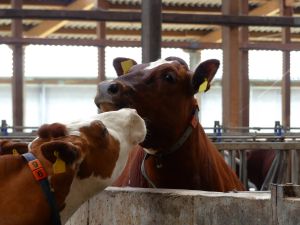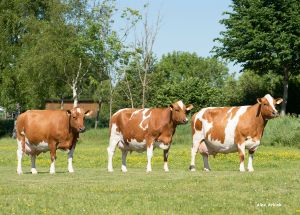Red & White dual pupose

Red & White dual purpose is a breed with high milk content and good fattening ability (Photo: A. Rolfes)
The Red & White dual purpose breed (RDN) has been bred independently since 1992 to counter the increasing influence of the Red Holsteins and to preserve the strengths of the original Red & White breed. Compared to the milk-emphasised Red Holsteins, the RDN have a better fattening performance with yields of about 7,442kg milk with high contents (4.35% fat, 324kg fat, 3.62% protein, 270kg protein). At the same time, they have a good longevity and fertility, which is underlined by an average calving interval of 378 days. Their roots can be traced back to 1887 to Red & White herdbook cows. In total, there are just under 3,500 herdbook cows in Germany. The largest part of the German population can be found in Schleswig-Holstein. Today, many farms there still concentrate specifically on breeding this dual-purpose breed.
The RDN breed is particularly popular because of its good suitability for pasture and at the same time can meet the requirements of special meat programmes. Due to the good fattening performance, higher sales prices can already be achieved for the calves. Altogether, the demand of the RDN for feed quality is lower than for Red Holsteins. All Red & White animals with up to 25 % Red Holstein blood percentage belong to the breeding line RDN.
Breeding objective
RDN are robust, adaptable cattle of medium frame with a height at the sacrum of about 145cm and a weight of about 700kg. Breeding focuses especially on the feet and legs and udders, so that a high productivity with a high longevity can be guaranteed. The breed produces very good carcasses with excellent meat quality. Quality parameters for meat and milk are weighted identically, with special attention to the protein content. The target daily gain of the breed is 1,300g.
Breeding programme
The breeding programme for RDN is still carried out conventionally, because selection according to genomic breeding values is not possible due to the smaller population size. Based on bull mother lists and pedigree information, the best cows of the RDN population in Schleswig-Holstein as well as the best cows of the Dutch MRIJ population are selected and mated with the best RDN/MRIJ bulls.
The resulting young bulls go into regular performance testing after the approval, so that a minimum number of daughters is guaranteed for the breeding value estimation later on. After the RDN bulls have completed their performance testing, they are kept as waiting bulls
and a sufficient semen stock is built up.
Calved daughters from the performance testing are described linearly within the progeny assessment. In the RDN population, the DN type
, i.e. muscling and harmony, is evaluated and not the dairy character. This DN score is included with 10% in the overall conformation score.
Important for unsing a RDN bull in the regular artificial insemination is the performance of the daughters as well as the individual breeding values of the RDN bull for conformation, longevity, udder health and fertility.
The challenge for any breeding programme of a small breed is to maintain genetic diversity. Thus, finding new bloodlines is an important task of the breeding organisations.
For more information on the RDN breed, please visit the RSH website.











